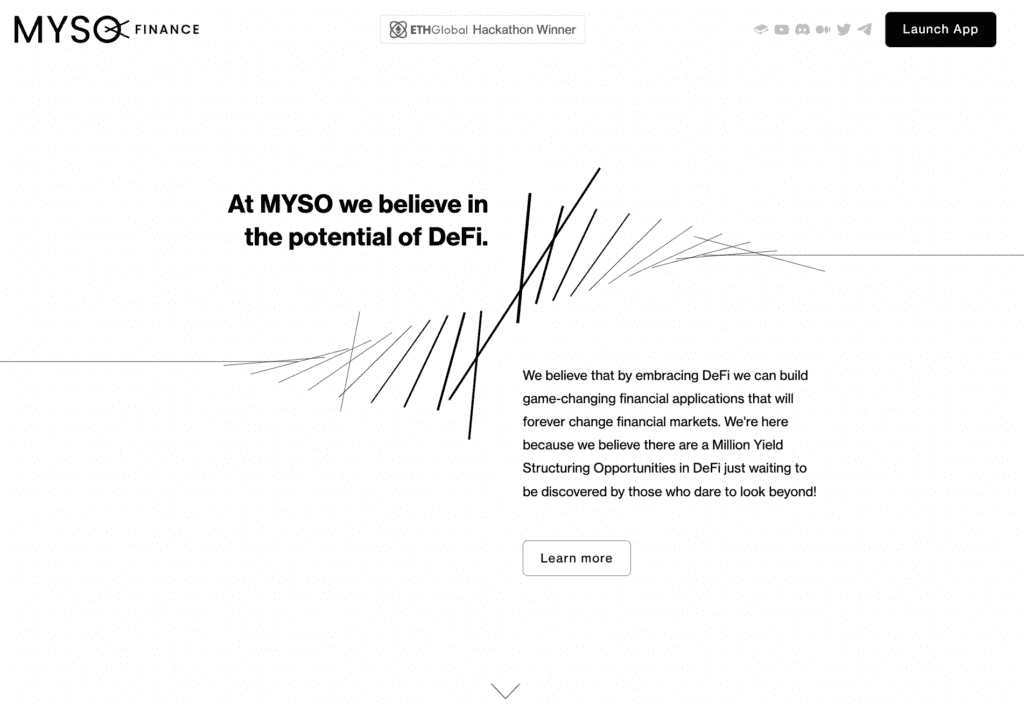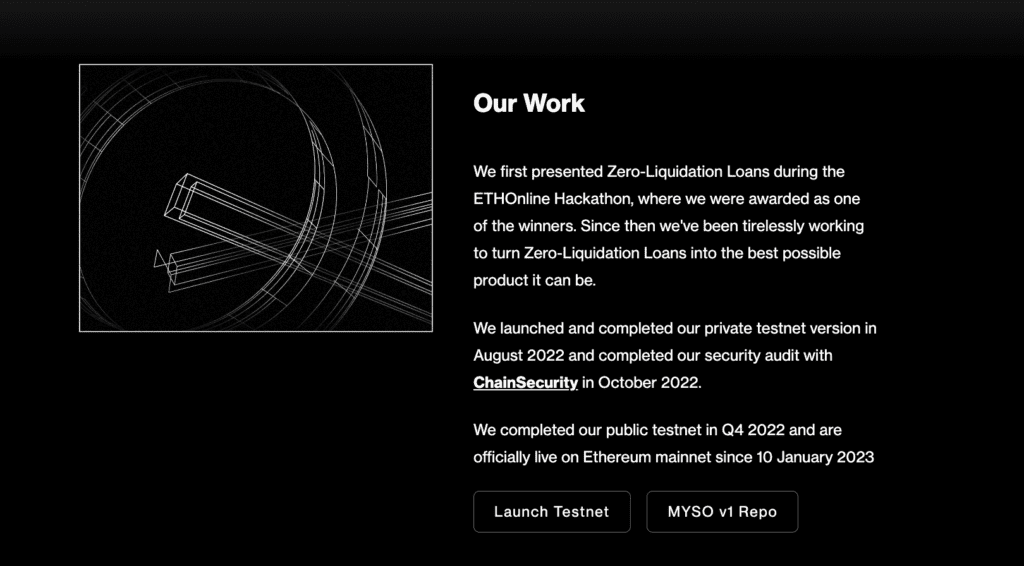MYSO Finance is a unique lending platform that has introduced a new lending mechanism called “Zero Liquidation Loans” (ZLL) on the Ethereum Virtual Machine (EVM). Unlike other lending platforms, MYSO Finance eliminates the risk of loan liquidation for borrowers when their collateral falls below a certain threshold.

The platform’s ZLL mechanism works by allowing borrowers to take out loans without having to worry about the risk of liquidation. This is because the platform uses a different model for calculating collateral requirements, which takes into account the volatility of the assets being used as collateral. This approach makes it easier for borrowers to manage their loans and reduces the risk of default.
MYSO Finance has two main objectives. The first is to simplify loans by creating a user-friendly platform that makes it easy for borrowers to take out loans and manage their collateral. The second objective is to provide a new strategy for liquidity providers. By eliminating the risk of liquidation, MYSO Finance provides liquidity providers with a new way to earn returns on their assets.
The platform is built on the Ethereum blockchain, which means that it is decentralized and transparent. This makes it easy for users to access the platform from anywhere in the world and to track their transactions in real-time.
MYSO Finance is a revolutionary lending platform that has introduced a new lending mechanism that eliminates the risk of loan liquidation. By simplifying loans and providing a new strategy for liquidity providers, MYSO Finance has changed the lending game and is poised to become a major player in the decentralized finance (DeFi) space.
How MYSO Finance Works?

Myso is a platform that allows anyone to create a liquidity pool, with each pool being determined by a set of required indicators. These indicators include the asset pair, such as wETH – rETH or rETH – RPL, the maximum loan amount based on collateral, the lending period, and the interest rate model.
Once a pool has been created and liquidity has been provided by the LPs, lenders are allowed to mortgage their assets in order to borrow. For example, a borrower could mortgage RPL in order to borrow USDC. The borrower must then repay the borrowed amount plus a fee to get their original property back. On the LPs’ side, their assets will be locked until the borrower repays their funds, and they will receive a percentage of the profits from their lending.
MYSO’s design includes a risk for borrowers who fail to repay their loan before the ZLL expires. They run the risk of losing their collateral. However, on the LPs’ side, MYSO allows them to earn a return on the risk that the loans won’t be repaid or the collateral falls in price.
Myso offers a flexible platform for creating liquidity pools with various parameters, providing borrowing opportunities for lenders with the ability to earn returns on the risk taken by LPs. It’s important to note that the information provided in this news has not been fact-checked or verified for plagiarism, and caution should be taken when relying on such information.
Libraries & Dependencies
The following OpenZeppelin 4.7.0 libraries are used:
- IERC20Metadata
- SafeERC20
Investor

MYSO Finance is invested by many large experienced funds in the market such as Houbi, Nexo, Wintermute,…
April 29, 2022: MYSO Finance raised $2.4 million in Seed round and the list of investors has not been announced yet
Rationale and Goals
The goal of the MYSO v1 protocol is twofold:
- Simplify crypto loans for borrowers by removing liquidations and associated overhead
- Provide a yield enhancement strategy for liquidity providers (LPs) to earn sustainable yield
These two objectives can be combined and made to complement one another using ZLLs. ZLLs serve as a mutually beneficial risk transfer mechanism by transferring the risk of loan liquidation from the borrower to the lender, who will then be compensated with a yield for doing so.
Zero-Liquidation Approach
The current DeFi lending landscape is dominated by protocols with liquidation-centric designs, that is, borrowers get liquidated and incur a liquidation penalty fee if the value of their collateral falls bellow a certain liquidation threshold.
Liquidation-centric borrowing systems introduce several systemic risks to the overall crypto market, including:
- Risk of cascading liquidations and over-liquidations
- Concentration risk
- Liquidation-related Maximal Extractable Value (MEV)
- Risk of oracle-related manipulations and exploits
Zero-Liquidation Loans (ZLLs) provide a novel approach to DeFi borrowing and lending that can help mitigate some of the aforementioned systemic risks and create a more robust and sustainable DeFi ecosystem.
Risks
Risks for LPs
- Collateral price risk: LPs are exposed to collateral price risk, i.e., if during the lifetime of a loan the associated pledged collateral becomes worth less than the owed repayment amount, a borrower will not have to repay and LPs will not earn the repayment amount but instead receive the depreciated collateral asset. Moreover, when a LP adds liquidity to a pool, it may happen that during the liquidity provisioning time the collateral price falls below the
maxLoanPerColl - Unpredictability of yield: the yield a LP can earn by adding liquidity to a pool cannot be known in advance. This is because, depending on how the collateral price changes, borrowers will repay or not, either yielding the repayment amount or the depreciated collateral. Secondly, the effective interest rate at which loans are given to borrowers is dynamic and changes depending on liquidity supply and demand – though, there is a lower bound rate r2 that defines the guaranteed lower bound at which LP’s capital is lent to borrowers
- Pool dilution: if other LPs add liquidity into a pool, previous LPs get diluted. This means that older LPs will fund new incoming loans at a lower pro-rata share, and, as a result, will also only be entitled to a lower pro-rata share of the associated loan proceeds. In case of large liquidity injections, dilution can be significant and potentially even cause claimable amounts to become negligible and prone to truncation errors.
- Minimum liquidity provisioning period: LPs must wait for a minimum liquidity provisioning period of 120 seconds before they can remove liquidity. During this time their capital is locked up.
- Overhead and costs of claiming: The process of claiming can come along with significant transaction overhead and gas costs, especially if the LP is trying to claim proceeds from a larger number of loans. While the aggregation mechanism can help make claiming more efficient, it cannot be guaranteed that the LP will be able to take advantage of the full aggregation benefits. This is because the eligibility to claim from buckets depends on the time that the LP added liquidity. Some claiming functions might allow LPs to overwrite certain claiming settings, which can lead to an irrevocable loss of entitled loan proceeds. Hence, LPs should call claiming related functions with great caution, especially when doing this programmatically or directly through Etherscan.
- Non-transferability of LP position: in MYSO v1, LP positions are non-fungible and nontransferable, meaning that the only way to recoup a liquidity contribution is by removing any unused liquidity and claiming from all entitled loan proceeds. In particular, there’s no secondary market through which a LP could convert their LP position into cash.
- Opportunity costs: if a LP adds liquidity into a pool it cannot be known in advance when the next borrower will arrive and when the LP’s liquidity contribution can be utilized to fund the next loan. Hence, LPs can incur opportunity costs when there’s little borrower activity in the pool. Moreover, once a loan has been settled, the corresponding loan proceeds aren’t automatically reinvested but instead the LP needs to first actively claim them and reinvest if desired. Hence, unclaimed loan proceeds may sit idle in the pool and cause opportunity costs for LPs.
Risks for borrowers
- Fixed repayment amounts: when a borrower takes out a ZLL, they lock in a fixed repayment amount. This means that if the pool’s borrow rates fall afterwards, the borrower will still have to pay the previously locked-in repayment amount. Moreover, borrowers should be aware that early repayment doesn’t lead to a lower APR, i.e., the repayment amount is constant and independent of how long the borrow position was open.
- Opportunity costs: when a borrower pledges collateral into a pool, any associated rewards aren’t automatically harvested for them (e.g., airdrops or the like).
Conclusion
MYSO is the new flavor in the Defi market. With the special mechanism “Loan not in liquidation (ZLL)”. Will MYSO bring attraction in the near future? Please read the article and give your personal opinion about this project. Hope this article brings a lot of useful information to everyone!
Website: https://www.myso.finance/
Youtube: https://www.youtube.com/@MysoFinance
Discord: https://discord.com/invite/AUTBZdxpUP
Twitter: https://twitter.com/MysoFinance
Telegram: https://t.me/MysoFinance
DISCLAIMER: The Information on this website is provided as general market commentary and does not constitute investment advice. We encourage you to do your research before investing.
Join us to keep track of news: https://linktr.ee/coincu
Website: coincu.com
Annie
Coincu News














